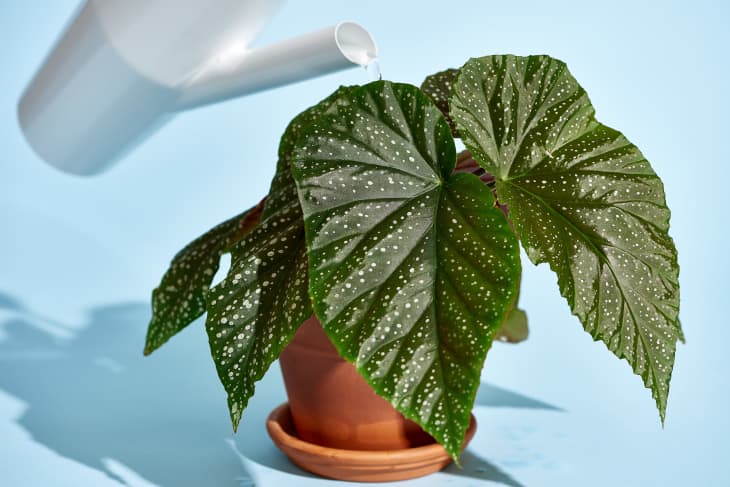So you’ve mastered growing pothos and your spider plant is sprouting baby plantlets like crazy. You’re feeling pretty good about your green thumb abilities and you’re looking for a bit of a gardening challenge—but, you know, nothing too challenging. It’s time for a begonia.
Begonias are some of the most beautiful, visually interesting plants you can grow indoors. However, they can be a bit picky about light and water, though not overly delicate, making them a great intermediate-level plant project. Here’s what you need to know.

Begonia Types
There is virtually no end to begonia variety. With over 1,000 species and many more varieties and hybrids, begonias come in countless colors, sizes, and shapes. There are four main types: fibrous, tuberous, canes, and rhizomatous.
The fibrous (also called wax begonias) and tuberous types are widely grown as annuals in garden beds. Fibrous types are generally selected for their flowers rather than their foliage.
Begonias that are grown indoors, on the other hand, are known for their show-stopping leaves, and these are the ones we’ll focus on here.
Cane begonias, commonly called angel wing begonias, have tall bamboo-like stems and slender teardrop shaped leaves that point downward. They have clusters of small white, pink, or red flowers, though the leaves, which come in many colors and are often speckled with silver, are arguably the real stars.
Rhizomatous begonias, so named because they grow from a stubby stem structure called a rhizome, have the showiest foliage in terms of color, shape, and texture. Many have fuzzy, variegated leaves in hues that range from light pink to deep purple and yellow to dark green.
Popular rex begonias are technically a subset of the rhizomatous category, but they’re often grouped separately because they are a bit more difficult to grow. ‘Rex’ means ‘king’ in Latin, a fitting name this group with the biggest, most extravagant leaves.
Planting
Plant begonias using a soilless potting mix in a pot with good drainage in the bottom. Begonias are particularly susceptible to root rot, so it can also be a good idea to add a layer pebbles or broken shards of old terracotta pots to the bottom for extra drainage. Repot begonias in a pot once size larger only when the pot becomes rootbound.
Watering
Striking the right balance with watering is the biggest challenge when growing begonias. Ideally, the soil should be slightly damp at all times, but not too wet because begonias are very sensitive to overwatering and can easily develop root rot. Test the soil with your finger before watering—the top inch should feel dry (approximately up to your first knuckle). If you are unsure if you should water, it is actually best to err on the side of caution and wait until the leaves begin to droop slightly, an indication that the plant is drying out. Water the soil directly, keeping the leaves dry.
Begonias also require high humidity to thrive, a challenge when growing them indoors. Rex begonias are fussier about humidity than other types. You might like to keep your begonia in the bathroom or kitchen where there’s likely to be more moisture in the air. You can also set a saucer of water near your plants, which will create humidity as it evaporates.
Caution: Don’t set the pot in the saucer of water since that could lead to overly wet roots and rot. You also should not spray begonias with water, especially rex begonias. Misting does create humidity, but begonias are prone to powdery mildew, so it’s better to keep the leaves dry.
Light
Cane begonias need bright, indirect sunlight. Rhizomatous and rex begonias prefer a bit more shade. If leaves appear scorched, move your plant to a less sunny spot.
Fertilization
Applying a liquid houseplant fertilizer according to the package instructions every two weeks will encourage bigger leaves and blooms.
Propagation
Begonias are fun and easy to propagate. Snip off a cutting and keep it in a jar of water until roots form before transferring it to a pot.
Toxicity
Begonias are toxic to pets, according to the ASPCA, though the most toxic portions of the plant are the underground tubers and roots.
Hải Yến
Gió bạn với cây tự buổi nào ,
Gió về cây lại ngất ngư chao .
Gió đi cây sẽ im lìm đứng,
Như kẻ lỡ làng dạ khát khao .
Hải Yến
Gió bạn với cây tự buổi nào , Gió về cây lại ngất ngư chao . Gió đi cây sẽ im lìm đứng, Như kẻ lỡ làng dạ khát khao .



